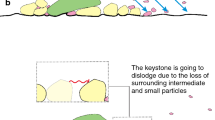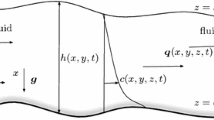Abstract
Experiments are performed in a mixing box to evaluate the effect of suspended sediment on turbulence generated by an oscillating grid. Quartz-density sand of varying sizes and concentrations is used, and particle image velocimetry is employed to quantify only the fluid phase. Results show that (1) while a relatively large secondary flow field is present in the box, turbulence is a maximum near the grid and it decreases systematically toward the water surface; (2) relatively high concentrations of fine sediment can markedly alter this secondary flow field and significantly decrease both the time-mean and turbulent kinetic energy within the flow, yet these same sediment concentrations have little effect on the integral time and length scales derived for each velocity component; and (3) the overall turbulence suppression observed can be related to the transfer of energy from the fluid to the sediment and the maintenance of a suspended sediment load rather than commonly employed turbulence modulation criteria. These experimental data demonstrate unequivocally that the presence of a suspended sediment load can significantly reduce overall turbulent kinetic energy, and these results should be applicable to a range of sediment-laden geophysical flows.













Similar content being viewed by others
References
Bagnold RA (1966), An approach to the sediment transport problem from general physics. U.S. Geological Survey Professional Paper 422-I, 37 pp
Balachandar S, Eaton JK (2010) Turbulent dispersed multiphase flow. Annu Rev Fluid Mech 42:111–133
Bennett SJ, Best JL (1995) Particle size and velocity discrimination in a sediment-laden turbulent flow using phase Doppler anemometry. J Fluids Eng 117:505–511
Bennett SJ, Bridge JS, Best JL (1998) Fluid and sediment dynamics of upper-stage plane beds. J Geophys Res 103(C1):1239–1274
Bennett SJ, Atkinson JF, Hou Y, Fay MJ (2013) Turbulence modulation by suspended sediment in a zero mean-shear geophysical flow. In: Venditti JG, Best J, Church M, Hardy RJ (eds) Coherent flow structures at the earth’s surface. Wiley, Chichester, pp 309–321. doi:10.1002/9781118527221.ch20
Best J, Bennett S, Bridge JS, Leeder M (1997) Turbulence modulation and particle velocities over flat sand beds at low transport rates. J Hydraul Eng 123:1118–1129
Bridge JS, Bennett SJ (1992) A model for the entrainment and transport of sediment grains of mixed sizes, shapes and densities. Water Resour Res 28:337–363
De Silva IPD, Fernando HJS (1998) Experiments on collapsing turbulent regions in stratified fluids. J Fluid Mech 358:29–60
Dietrich WE (1982) Settling velocity of natural particles. Water Resour Res 18(6):1615–1626
Dohan K, Sutherland BR (2002) Turbulence time scales in mixing box experiments. Exp Fluids 33:709–719
Elghobashi S (1994) On predicting particle-laden turbulent flows. Appl Sci Res 52:309–329
Elghobashi S, Truesdell GC (1993) On the two-way interaction between homogeneous turbulence and dispersed solid particles. II: turbulence modification. Phys Fluids A 5(7):1790–1801
García MH (2008) Sediment transport and morphodynamics. In García MH (ed) Sedimentation engineering: processes, management, modeling, and practices. ASCE Manuals and Reports on Engineering Practice No. 110, American Society of Civil Engineers, Reston, VA, pp 21–163
Gore RA, Crowe CT (1989) Effect of particle size on modulating turbulent intensity. Int J Multiph Flow 15:279–285
Gore RA, Crowe CT (1991) Modulation of turbulence by a dispersed phase. J Fluids Eng 113:304–307
Hetsroni G (1989) Particle-turbulence interaction. Int J Multiph Flow 15:735–746
Hinze JO (1959) Turbulence. McGraw-Hill, New York
Hopfinger J, Toly JA (1976) Spatially decaying turbulence and its relation to mixing across density interfaces. J Fluid Mech 78:155–175
Hou Y (2011) Turbulence modulation by suspended sediment within a mixing box. MS thesis, University at Buffalo, Buffalo
Huppert HE, Turner JS, Hallworth MA (1995) Sedimentation and entrainment in dense layers of suspended particles stirred by an oscillating grid. J Fluid Mech 289:263–293
Kaftori D, Hetsroni G, Banerjee S (1995) Particle behavior in the turbulent boundary layer. I. Motion, deposition, and entrainment. Phys Fluids 7:1095–1106
Leeder MR, Gray TE, Alexander J (2005) Sediment suspension dynamics and a new criterion for the maintenance of turbulent suspensions. Sedimentology 52:683–691
Li Y, McLaughlin JB, Kontomaris K, Portela L (2001) Numerical simulation of particle-laden turbulent channel flow. Phys Fluids 13:2957–2967. doi:10.1063/1.1396846
Lucci F, Ferrante A, Elghobashi S (2011) Is Stokes number an appropriate indicator for turbulence modulation by particles of Taylor-length-scale size? Phys Fluids 23:025101
Lyn DA (1991) Resistance in flat-bed sediment-laden flows. J Hydraul Eng 117:94–114
Lyn DA (1992) Turbulence characteristics of sediment-laden flows in open-channels. J Hydraul Eng 118:971–988
Matsunaga N, Sugihara Y, Komatsu T, Masuda A (1999) Quantitative properties of oscillating-grid turbulence in a homogeneous fluid. Fluid Dyn Res 25:147–165
McKenna SP, McGillis WR (2004) Observations of flow repeatability and secondary circulation in an oscillating grid-stirred tank. Phys Fluids 16:3499–3502
Michallet H, Mory M (2004) Modelling of sediment suspensions in oscillating grid turbulence. Fluid Dyn Res 35:87–106
Muste M, Yu K, Fujita I, Ettema R (2005) Two-phase versus mixed-flow perspective on suspended sediment transport in turbulent channel flows. Water Resour Res 41:W10402. doi:10.1029/2004WR003595
Nezu I, Azuma R (2004) Turbulence characteristics and interaction between particles and fluid in particle-laden open channel flows. J Hydraul Eng 130:988–1001
Noh Y, Fernando HJS (1991) Dispersion of suspended particles in turbulent flow. Phys Fluids A 3:1730–1740
Orlins JJ, Gulliver JS (2003) Turbulence quantification and sediment resuspension in an oscillating grid chamber. Exp Fluids 34:662–677
Pope SB (2000) Turbulent flows. Cambridge University Press, New York
Schreck S, Kleis SJ (1993) Modification of grid-generated turbulence by solid particles. J Fluid Mech 249:665–688
Tanaka T, Eaton JK (2008) Classification of turbulence modification by dispersed spheres using a novel dimensionless number. Phys Rev Lett 101:114502
Tennekes H, Lumley JL (1972) A first course in turbulence. The MIT Press, Cambridge
Thompson SM, Turner JS (1975) Mixing across an interface due to turbulence generated by an oscillating grid. J Fluid Mech 67:349–368
Zhao L, Andersson HI, Gillissen JJJ (2013) Interphasial energy transfer and particle dissipation in particle-laden wall turbulence. J Fluid Mech 715:32–59
Acknowledgments
We would like to thank Kevin Cullinan and Michael Fay for technical assistance with the experiments, Mike Leeder for helpful discussions on his suspension criterion, and the anonymous referees for suggesting ways to improve the clarity of the paper. This research was supported by NSF EAR 0549607.
Author information
Authors and Affiliations
Corresponding author
Rights and permissions
About this article
Cite this article
Bennett, S.J., Hou, Y. & Atkinson, J.F. Turbulence suppression by suspended sediment within a geophysical flow. Environ Fluid Mech 14, 771–794 (2014). https://doi.org/10.1007/s10652-013-9323-2
Received:
Accepted:
Published:
Issue Date:
DOI: https://doi.org/10.1007/s10652-013-9323-2




